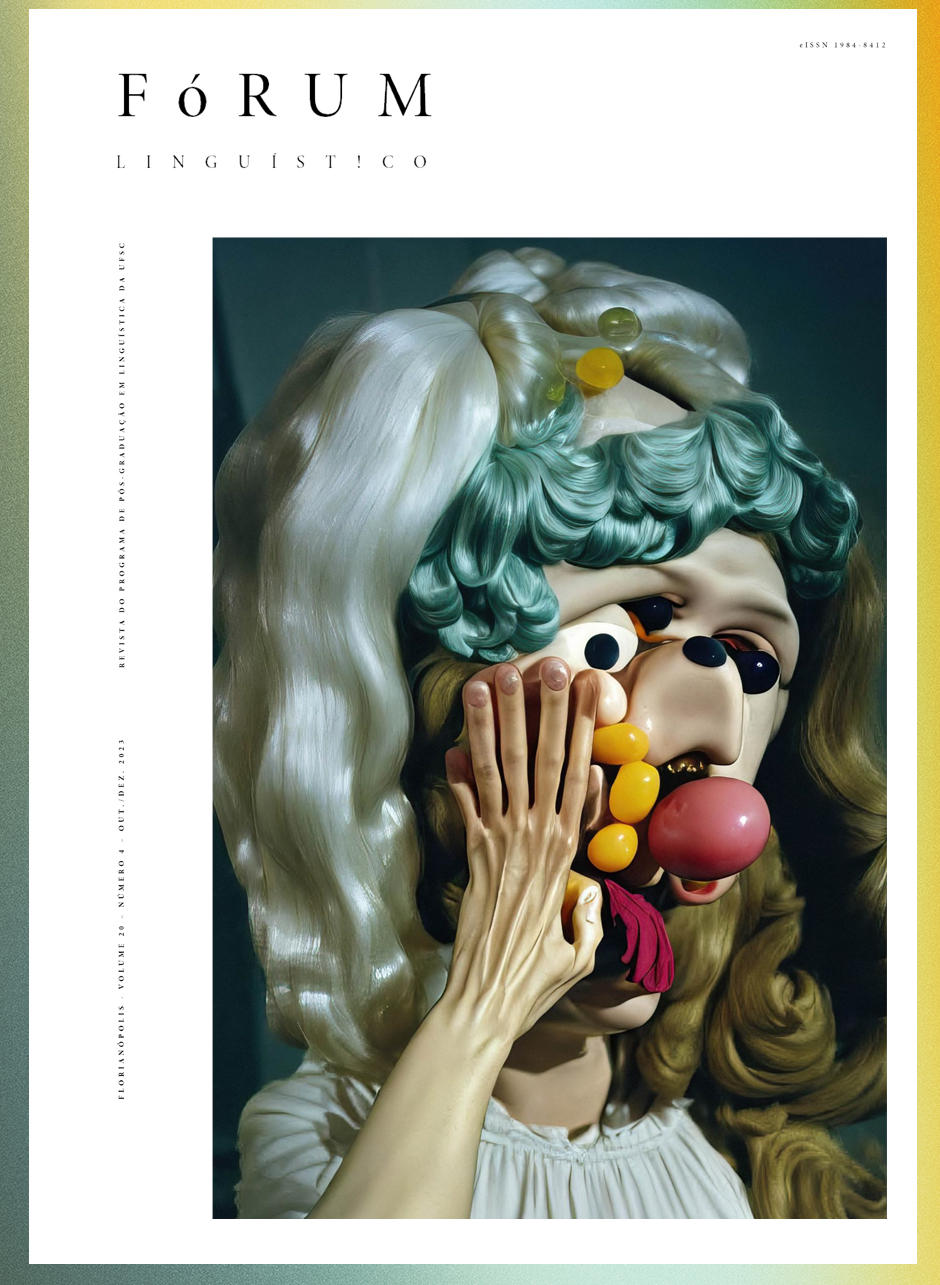The text-image relationship in the journalistic discourse through the critical linguistics perspective
DOI:
https://doi.org/10.5007/1984-8412.2023.e85517Keywords:
Journalistic discourse, Organization of elements, Balance Structure, Linguistic styleAbstract
Given the importance and power of the news in contemporary society, it is not surprising that journalistic discourse is so studied. Such discourse has specific characteristics and methods of production and consumption. The aim of this article is to identify the interrelationship between written texts and images on the front pages of two printed newspapers from Minas Gerais, produced during the Covid-19 pandemic, based on the linguistic style, the analysis of the organization of the elements, the Equilibrium Structure provided by producers and the discursive practices that shape journalistic discourse. In order to achieve the aims, I seek support in Critical Discourse Analysis. On the other hand, studies that specifically analyze the discursive practices of journalistic discourse are extremely important. The results show that the linguistic resources were adjusted to the target audience, the images established important relationships with the written texts and the news value proved to be important in the making of the covers.
References
BAKTHIN, M. Marxismo e a Filosofia da Linguagem. São Paulo: Hucitec. 2006.
BATEMAN, J. Multimodality and Genre. Ed. Palgrave. London. 2008.
BEDNAREK, M; CAPLE, H. News Discourse. Ed. Continuum. N.Y. 2012.
BLOMMAERT, J. The debate is open. In. Language ideological debates. Ed. Mouton Gruyter. New York. 1999.
BLOMMAERT, J. Discourse: A critical introduction. Ed. Cambridge. Cambridge. 2005.
CAPLE, H. Playing with words and pictures: intersemiosis in a new genre of news reportage. Ph.D. Thesis, Department of Linguistics, University of Sydney. 2009b.
CAPLE, H. Doubling-up: allusion and bonding in multi-semiotic news stories. In. New Discourse on Language: Functional Perspectives on Multimodality, Identity, and Affiliation. Ed. Continuum. New York. 2010a.
COTTER, C. Investigating the Language of Journalism. Ed. Cambridge University Press. New York. 2010.
COX, R.W. Beyond empire and terror: critical reflections on the political economy of the world order. In. New political economy. Nº09, vol. 03. 2004. p.p307-323.
DONDIS, D. A. A Primer of Visual Literacy. London: MIT Press.1973.
FAIRCLOUGH, N. Discourse and social change. Ed. Arnold. London. 1992.
FARICLOUGH, N. Discourse and Social Change. Cambridge: Polity. 1994.
FAIRCLOUGH, N. Media Discourse. Ed. Arnold. London.1995b.
FAIRCLOUGH, N. Critical discourse analysis: the critical study of language. Ed. Longman. London. 2003.
FAIRCLOUGH, N. Analysing discourse: textual analysis research. Ed. Routledge. London. 2003.
FOWLER, R. Language in the news. Ed. Routledge. London. 1991.
GALTUNG, J; RUGE, M. Structuring and selecting news. In. The manufacture of new: social problems, deviance and the news media. Ed. Constable. London. 1965. p.p. 62-72.
GRAMSCI, A. Quaderni del Carcere. Edição crítica do Instituto Gramsci, org. Valentino Gerratana. Ed. Einaudi. Turim. 1977.
HALLIDAY, M. A. K. Language and a Social Semiotic: The social interpretation of language and meaning. London: Ed. Edward Arnold. 1978.
HALLIDAY, M. A. K. An Introduction to Functional Grammar. E. Edward Arnold. London. 1994.
HALLIDAY, M. A. K.; MATTHIESSEN, C. M. I. M. An Introduction to Functional Grammar. 3. ed. Ed. Arnold. London. 2004.
IASBECK, L. C. A. A arte dos slogans: as técnicas de construção das frases de efeito no texto publicitário. Ed. Annablume. São Paulo. 2000.
IGGERS, J. Good news, bad news: journalism ethics and the public interest. Ed. Westview press. Boulder. 1999.
JUCKER, A.H. Social stylistics: syntactic variation in British newspaper. Ed. Mouton Gruyter. Berlin. 1992.
KRESS, G.; HODGE, R. Language as ideology. Ed. Routledge. London. 1979.
KRESS, G.; van LEEUWEN, T. Colour as a semiotic mode: notes for a grammar of colour. Sage Publications. London. 2002.
KRESS, G.; van LEEUWEN, T. Reading images: The grammar of visual design. 2. ed. Ed. Routledge. London. 2006.
KRESS, G.; van LEEUWEN, T . Reading images: The grammar of visual design. 2. ed. Ed. Routledge. London. 2021.
LUKE, A. Beyond science and ideology critique: developing critical discourse analysis. In. Annual Review of Applied Linguistics, Nº 22, 2002. p. 96-110.
McLELLAN, D. Ideology. Ed. Minnesota Press. Minneapolis. 1986.
MEINHOF, U.H. Language in the age of satellite television. Ed. Oxford University Press. Oxford. 1998.
MILLS, C. Feminist stylistics. Ed. Routledge. London. 1995.
O’NEILL, J. Journalism in the market place. In. Ethical issues in journalism and the media. Ed. Routledge. London. 1992. p.p.15-32.
PHILLLIPS, L; JORGENSEN, M.W. Discourse analysis as theory and method. Ed. Sage. London. 2002.
REISIGL, M; WODAK, R. Discourse and discrimination: rhetorics of racism and anti-semitism. Ed. Routledge. London. 2001.
RICHARDSON, J.E. Analysing newspapers: an approach from Critical Discourse Analysis. Ed. Palgrave. London. 2007.
TITSCHER, S; MEYER, M; WODAK, R; VETTER, E. Methods of text and discourse analysis. Ed. Sage. London. 2000.
TUCHMAN, G. Objectivity as strategic ritual. In. American journal of sociology, vol. 77.1972. p.p. 660-679.
VIVANCO, V. The absence of connectives and the maintenance of coherence in publicity texts. Journal of Pragmatics, n. 37, 2004. p. 1233-1249.
WODAK, R. Disorders of discourse. Ed. Longman. London. 1996.
Downloads
Published
Issue
Section
License

This work is licensed under a Creative Commons Attribution-NonCommercial-NoDerivatives 4.0 International License.
Rights including those in copyright in the content of the published works are owned by Revista Forum Linguistico. Complete or parcial reprint should be authorized by the Editorial Board of the Journal. In case of authorization, the source of the original publication must be stated.


